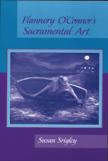Ethics As Fiction
The Catholic fiction writer from Georgia, Flannery O’Connor (1925-64), once volunteered that it would be 50 years before readers understood her stories. Half a century after the publication of her first novel, Wise Blood (1952), and the inaugural collection of her short stories, A Good Man Is Hard to Find (1955), interpreters of O’Connor gain well-timed momentum through Susan Srigley’s stimulating, cogent analyses.
Flannery O’Connor’s Sacramental Art breaks significant new ground, exploring the ethical implications of O’Connor’s sacramental view of reality. Srigley describes her task: “to approach ‘ethics as fiction.’” Defining Christ’s love as “love that serves one’s neighbor, a love for neighbor that equals or surpasses love of self,” she proposes such love as the source of O’Connor’s “ethic of responsibility.” Her analysis suggests how O’Connor’s attention to the interiority (ethos) of fictional characters either gives rise to responsible action or exhibits a vacuous inertia.
The first chapter assesses the influence of Jacques Maritain and Thomas Aquinas. Such scrutiny is wisely aimed, because O’Connor described herself as a “hillbilly Thomist.” Srigley translates challenging philosophical and aesthetic principles into lean, illuminative sentences. A Canadian who teaches religions and cultures at Nipissing University, in North Bay, Ontario, she mines Maritain’s sense of “the habit of art,” and “the work of the intellect to make it live” as key to understanding O’Connor’s métier.
The chapter “Sacramental Theology and Incarnational Art” renders a Catholic understanding of the intellect as integral to the soul’s movement toward mystery. Contemporary Catholics who bemoan the fundamentalism of catechisms and narrow moralizing will take heart from O’Connor’s caveat, duly noted in Flannery O’Connor’s Sacramental Art: “We Catholics are very much given to the Instant Answer. Fiction doesn’t have any.” No wonder she identified the great Catholic sin as “smugness.”
O’Connor finds the compass for her fiction writing in the marriage of transcendental beauty, the beauty that God beholds, with aesthetic beauty, the beauty perceived through the human senses. In her vision of reality, the horizon of the visible world opens to the invisible world. The physical unites with the spiritual, challenging the dominant culture’s ignorance of spiritual reality. (Srigley seems unaware of O’Connor’s debt to William F. Lynch, S.J., although she interweaves references to the analogical imagination and the interpenetration of finite and infinite.)
Srigley takes issue with critics who radically separate O’Connor’s theological inquiry from her fictional landscapes and characters. She demonstrates how the two are integrally connected in the religious artist’s imagination. Individual chapters on O’Connor’s two novels, Wise Blood and The Violent Bear It Away (1960) and the short story “Revelation,” from the posthumously published collection Everything That Rises Must Converge (1965), offer Srigley’s interpretations in terms of an “ethic of responsibility.”
One disappointment I have about Flannery O’Connor’s Sacramental Art is that it evaluates so few short stories (her forte) vis-à-vis the ethic of responsibility. Her stories were frequently nominated for the O. Henry Award, which she received numerous times. Granted that “Revelation” is a signature O’Connor work (and Srigley’s analysis proves insightful about Ruby Turpin’s “purgatorial vision”), discussing this one short story only alongside two novels is a marked imbalance.
A substantive concern is Srigley’s interpretation of Hazel Motes, the protagonist of Wise Blood. She concludes that Hazel’s self-blinding “reveals his continued misperception of spiritual reality” and that his atonement by ascetic practices implies a return to his family’s religious views. Along with Richard Giannone and other O’Connor scholars, I perceive authentic conversion beyond his philosophical quest, as he confronts false religion and its surrogates with the exclamation, “It ain’t true.” O’Connor insisted that something in storytellers and their listeners “demands the redemptive act…demands that what falls at least be offered the chance to be restored”—as well as the costly grace that measures “the price of restoration.” I would also suggest that Tarwater’s drowning-and-baptism of Bishop in The Violent Bear It Away is a more intentionally ambivalent action than Srigley seems to think. If the novel is truly “a minor hymn to the Eucharist” as O’Connor described it to one correspondent (a quotation Srigley surprisingly omits), then the form of words for the meaning of sacrament bears more theological significance than she allows.
As a theologian who has used Flannery O’Connor’s fiction in teaching undergraduates and graduate students for over a decade, I applaud Srigley’s approach to “ethics as fiction” and look forward to more of her provocative and intelligent interpretations of Flannery O’Connor.
This article also appeared in print, under the headline “Ethics As Fiction,” in the May 9, 2005, issue.








